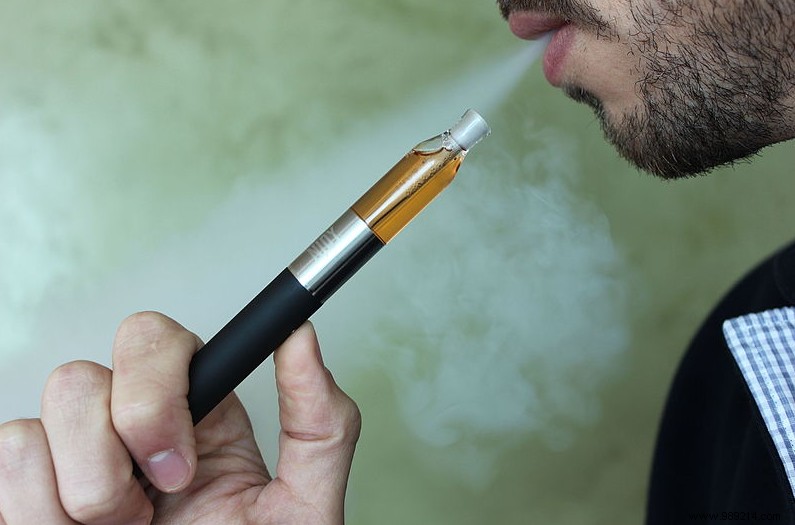The study of scientific literature intended to assess the benefit-risk ratio of electronic cigarettes has always been confusing. Indeed, between the contradictory conclusions, the suspicions of lobbying on the part of the tobacco and vaping industry (in one direction or the other) and the reduced, sometimes anecdotal, durations of the follow-up of the participants are perplexing.
Since its invention, twenty years ago, by a Chinese pharmacist, the electronic cigarette has still not been unanimous , nor on its efficacy and harmlessness in the fight against smoking, nor on its dangerousness. As you will see, and with the exception of rare (small) breakthroughs, the most recent studies have not really advanced the debate... Contrary to the positions of health authorities which seem to be moving towards a "lesser evil" policy with regard to the absence of certain harmful substances resulting from the combustion of tobacco.
Let's start this overview with the most recent study (February 2021), carried out by researchers at the University of North Carolina. News obliges, this research work was interested in the immune response of vapers against viruses . Conclusion:E-cigarettes appear to induce changes in the nasal mucosa, altering the release of cytokines and chemokines and thus impairing the host's respiratory antiviral defense. But this study suffers from a very common bias in this type of work:the researchers do not specify whether the participants, current vapers, are former smokers … Which is very often the case.
Another study, also published in February 2021, looked at e-liquid aromas vaped. This research work published in the America Journal of Physiology – Lung Cellular and Molecular Physiology , explains that some aromas are more harmful than others, significantly reducing the ability of immune system cells to eliminate bacteria and regulate inflammation . According to the study, the most harmful aromas would be chocolate and banana , which display higher levels of a chemical compound called the "benzene ring". However, the flavors in question can be "lightened" to reduce the concentration of this substance. This is the first research work that has compared the aromas of e-liquids and their degree of harmfulness.
Let's now take a look at this ambitious report produced by a group of toxicologists commissioned by the British government (September 2020). This document comes to crown a study of more than a year which has set out to assess the dangerousness of vaped e-liquids . Here are the main conclusions to take away from this research work, which should form a new basis for many future studies:
Finally, a study carried out by Boston University in early 2021 looked at the cardiovascular toxicity of electronic cigarettes . To do this, the researchers used 2014 data from previous work by the Population Assessment of Tobacco and Health (PATH). Conclusion:was rated “ no difference in the concentration of inflammatory or oxidative stress biomarkers between participants who used e-cigarettes and non-users " .

"Evali" is the name of a pneumonia that has emerged in the United States, notably in New York and Texas, which usually begins as an acute resistant pneumonia. antibiotic therapy. An epidemic was recorded in September 2019 , followed by an investigation by US health authorities. It was quickly established that the overwhelming majority of patients had a history of vaping. As of February 18, 2020,2,807 cases have been reported in 29 U.S. states , with 68 deaths. At first, the electronic cigarette was pinned down, leading to cascading bans.
A few days later, it was shown that the vast majority of patients had actually taken tetrahydrocannabinol or THC , which is the active ingredient in cannabis. In addition, the e-liquids consumed were adulterated. Other patients also consumed an e-liquid which, in addition to being adulterated, contained illegal substances such as tocopherol acetate (or vitamin E acetate) and cannabinoids. We are in a case of misuse and use of expired products . This is what the National Academy of Medicine recalled in a press release:“ The American epidemic of lung damage is due to a diversion of its use because, after having blamed vaping as such, the CDC and the FDA recognize that this diversion is the main cause of this epidemic " .
In the countries of the European Union, the electronic cigarette has not been so linked to controversies over its use. It must be said that the majority of countries had taken strict legal provisions to regulate vaping devices since their democratization at the end of the 2000s. Countries such as the United States, Thailand, India and even Brazil have accumulated coasters, with restrictions ranging from drastic to light. , to then start again with a frank ban in certain regions, in particular the states of New York and Michigan on the side of the country of Uncle Sam after the episode of Evali pneumonia.
In France, the health authorities now seem to be adopting a more pragmatic approach, no doubt after noting the role played by electronic cigarettes in the smoking cessation of hundreds of thousands ex-smokers . This finding was quantified and quantified by Public Health France, as we will see below. Also, the French health authorities seem to be moving towards a strict framework for the chemical composition of e-liquids allowed to be marketed in the territory as well as towards an increase in penalties for specialized shops and online sites that sell vaping devices to minors.
In France, there is no ban on the sale of vaping devices. The legislation governing vaping is modeled on that of tobacco , with a ban on vaping in schools, on public transport, etc. These restrictions were enacted in October 2017, under the government Édouard Philippe. Reductions have been made as the role of electronic cigarettes in smoking cessation has been confirmed empirically , that is, on the ground. Thus, it is allowed to vape in certain public places such as stadiums, bars and restaurants, under the decision of the owner (internal regulations) or with a municipal decree.
The advice of the "Wise Men" has always influenced public health policy decisions. It must be said that the National Academy of Medicine, which emerged from the former Royal Academy of Medicine (1820) and the Royal Academy of Surgery (1731), plays the role of leading advisor in matters health policy , while issuing opinions or press releases without prior solicitation, in particular to disseminate the results of studies. The Academy of "Sages" is both financed by the state budget and by own funds.
It is in this context that the National Academy of Medicine declared itself, in 2015, for the integration of the electronic cigarette in the government strategy of tobacco control , in the same way as nicotine patches for example. The National Academy of Medicine spoke out again in late 2019 on this topic, first to warn policymakers about the "misinformation" that surrounded the "Evali" episode in the United States, then to reiterate its position on the contribution of electronic cigarettes in the fight against smoking in France, with supporting figures.
So in a statement titled “ The National Academy of Medicine recalls the proven advantages and the unduly alleged disadvantages of the electronic cigarette (vaporette) " , the Academy of Medicine openly criticizes the position of the World Health Organization (WHO) following the outbreak of Evali lung diseases in the United States. “ Without arguing, the WHO qualifies the electronic cigarette as indisputably harmful " .

For the National Academy of Medicine, the purpose is not to decide on the harmfulness of the electronic cigarette. It is indeed obvious that the inhalation of flavored substances and nicotine does not really meet the definition of health and well-being on a daily basis . On the other hand, the vaporette is de facto less dangerous than the traditional cigarette in view of its chemical composition which ignores tar, carbon monoxide and other toxic and potentially carcinogenic substances. For the National Academy of Medicine, it is a policy of the lesser evil which must be followed. The electronic cigarette cannot be "evaluated" without comparison with the traditional cigarette which it is supposed to replace temporarily, for a gradual weaning.
The High Authority for Health (HAS) fulfills four main missions:
The High Authority for Health (HAS) adopts a more nuanced position, but does not oppose frontally and categorically electronic cigarette as a smoking cessation aid. In his guide “ Questions and answers on smoking cessation ", one can for example read:"The HAS does not recommend the electronic cigarette as a tool for quitting smoking, but considers that its use in a smoker who has started vaping and who wants to quit should not be discouraged ". Further, in the part of the methods recommended by the HAS for quitting smoking, the organization explains that if the electronic cigarette “ cannot be recommended” because “its efficacy and safety have not been adequately evaluated ” in the current state of knowledge, “ its temporary use by smokers who wish to quit should not be discouraged " .
Also, and even if linguistic precautions are taken here again, HAS accepts the hypothesis that electronic cigarettes contain fewer toxic substances than traditional cigarettes. “ The electronic cigarette, with or without nicotine, is not a trivial consumer product , because, even if it contains less than the traditional cigarette, it also contains toxic products " . This assertion is in line with the policy of the lesser evil advocated by the National Academy of Medicine.
To provide a relevant and pragmatic response to the issue of traceability of e-liquids vaped in France, ANSES has set up a tool free and accessible to all that lists the chemical composition of all vaping products authorized in France. Through this approach, ANSES wishes to eliminate the conditions that have led to the appearance of EVALI pneumonia in certain American states.